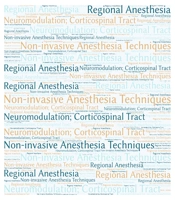One of the emerging methods that has generated significant optimism for problem-solving is the use of brain-computer interfaces (BCIs), which facilitate interaction between the computer and the brain to address underlying issues (1, 2). Over the decades, anesthesiologists have sought less risky and less invasive methods for anesthesia planning; BCIs may offer an alternative to achieve this objective. For instance, BCIs could be utilized to selectively block only the sensory and motor nerve pathways related to the lower or upper limb during surgery. This approach could lead to a computer-based regional anesthesia method. Thus, without the use of medication or the need for needles or other invasive techniques, the patient's selected region could be anesthetized at the precise and specified time for the operation and returned to a normal state with a single click. To achieve this, the anatomical pathways from the cortex to the thalamus and then to the anterior spinal tracts (i.e., the motor pathway) should be traced (3). Simultaneously, the return route (i.e., the sensory pathway) should be controlled using a similar approach (3), both utilizing BCIs. Although this concept is still in its infancy, it could be considered alongside novel technologies used for treating neurological disorders with BCIs (4).
Journal of Cellular & Molecular Anesthesia

Image Credit:J Cell Mol Anesth
Outlines
The Role of Brain Computer Interface in Regional Anesthesia
Author(s):
1Department of Anesthesiology, Shahid Modarres Hospital, School of Medicine, Shahid Beheshti University of Medical Sciences, Tehran, Iran
2Anesthesiology Research Center, Shahid Beheshti University of Medical Sciences, Tehran, Iran
Published online:May 21, 2025
Article type:Editorial
Received:May 17, 2025
Accepted:May 17, 2025
How to Cite:Dabbagh A. The Role of Brain Computer Interface in Regional Anesthesia.J Cell Mol Anesth.2025;10(2):e162947.https://doi.org/10.5812/jcma-162947.
Footnotes
References
- 1.Penev Y, Beneke A, Root K, Meisel E, Kwak S, Diaz M, et al. Therapeutic Effectiveness of Brain Computer Interfaces in Stroke Patients: A Systematic Review. J Experim Neurol. 2023;4:87-93. https://doi.org/10.33696/Neurol.4.077.
- 2.Wolpaw JR, Millan JDR, Ramsey NF. Brain-computer interfaces: Definitions and principles. Handb Clin Neurol. 2020;168:15-23. [PubMed ID: 32164849]. https://doi.org/10.1016/B978-0-444-63934-9.00002-0.
- 3.Natali AL, Reddy V, Bordoni B. Neuroanatomy, Corticospinal Cord Tract. Treasure Island (FL); 2025.
- 4.Maiseli B, Abdalla AT, Massawe LV, Mbise M, Mkocha K, Nassor NA, et al. Brain-computer interface: trend, challenges, and threats. Brain Inform. 2023;10(1):20. [PubMed ID: 37540385]. [PubMed Central ID: PMC10403483]. https://doi.org/10.1186/s40708-023-00199-3.
Copyright
Copyright © 2025, Dabbagh. This open-access article is available under the Creative Commons Attribution 4.0 (CC BY 4.0) International License (https://creativecommons.org/licenses/by/4.0/), which allows for unrestricted use, distribution, and reproduction in any medium, provided that the original work is properly cited.
Crossmark
Checking
Comments
Number of Comments:0Cited by
Purchasing Reprints
- Copyright Clearance Center (CCC) handles bulk orders for article reprints for Brieflands. To place an order for reprints, please click here ( https://www.copyright.com/landing/reprintsinquiryform/ ). Clicking this link will bring you to a CCC request form where you can provide the details of your order. Once complete, please click the ‘Submit Request’ button and CCC’s Reprints Services team will generate a quote for your review.
Search Relations
Related Articles